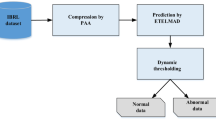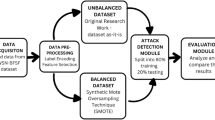Abstract
In this paper an extreme learning machine (ELM) based approach is presented for the anomaly detection in dynamic wireless sensor network (WSN) under extremely imbalanced class distribution conditions. The imbalanced class distribution and dynamic nature of the network result in the classifier's inferior performance. The proposed approach tackles the imbalanced classification of datasets by dividing the class with the majority of samples into multiple sub-classes. This is achieved by splitting the majority-class samples evenly into multiple segments using Affinity Propagation (AP). The initial preferences for AP are set to influence the total number of segments such that the number of samples in any segment closely matches with the numbers of minority-class samples. Such sections of the dataset together with the minor class are then viewed as different classes and used to train the ELM. The synthetic datasets required to evaluate the performance of the proposed technique are generated using network simulator version 2 (NS2). The dynamic WSN is simulated for different attacks (considering only one attack at a time) using network simulator version 2 (NS2). During the simulation, all required network data is dumped into trace files. These dumped trace files are later processed through MATLAB to extract the required features in a usable format to generate a proper dataset. This process is repeated for two different WSN configurations, one with lower node density, and the other with higher node density, and the generated datasets for these two WSN configurations are denoted as Dataset-1, and Dataset-2 respectively. The experimental findings support the substantial improvement in performance from previous approaches by the new technique.













Similar content being viewed by others
Explore related subjects
Discover the latest articles, news and stories from top researchers in related subjects.References
Abdiansah A, Wardoyo R (2015) Time complexity analysis of support vector machines (SVM) in LibSVM. Int J Comput Appl 128:28–34
Ahmad B, Jian W, Ali ZA et al (2019) Hybrid anomaly detection by using clustering for wireless sensor network. Wirel Pers Commun 106:1841–1853. https://doi.org/10.1007/s11277-018-5721-6
Ali A, Ming Y, Chakraborty S, Iram S (2017) A comprehensive survey on real-time applications of WSN. Future Internet 9:77. https://doi.org/10.3390/fi9040077
Ali WA, Manasa KN, Bendechache M et al (2020) A Review of current machine learning approaches for anomaly detection in network traffic. J Telecommun Digit Econ 8:64–95
Aymen A, Kachouri A, Mahfoudhi A (2014) Anomaly detection in WSN: critical study with new vision. Proc Eng Technol (PET) 5:37–46
Batiha T, Prauzek M, Krömer P (2020) Intrusion detection in wireless sensor networks by an ensemble of artificial neural networks. In: Czarnowski I, Howlett RJ, Jain LC (eds) Intelligent decision technologies 2019. Springer, Singapore, pp 323–333
Bhushan B, Sahoo G (2018) Recent advances in attacks, technical challenges, vulnerabilities and their countermeasures in wireless sensor networks. Wireless Pers Commun 98:2037–2077. https://doi.org/10.1007/s11277-017-4962-0
Bielza C, Li G, Larrañaga P (2011) Multi-dimensional classification with Bayesian networks. Int J Approx Reason 52:705–727. https://doi.org/10.1016/j.ijar.2011.01.007
Cauteruccio F, Fortino G, Guerrieri A et al (2019) Short-long term anomaly detection in wireless sensor networks based on machine learning and multi-parameterized edit distance. Inf Fusion 52:13–30. https://doi.org/10.1016/j.inffus.2018.11.010
Chandola V, Banerjee A, Kumar V (2009) Anomaly detection: a survey. ACM Comput Surv 41:151–1558. https://doi.org/10.1145/1541880.1541882
Chapelle O (2007) Training a support vector machine in the primal. Neural Comput 19:1155–1178. https://doi.org/10.1162/neco.2007.19.5.1155
Chen Y-W, Lin C-J (2006) Combining SVMs with various feature selection strategies. In: Guyon I, Nikravesh M, Gunn S, Zadeh LA (eds) Feature extraction: foundations and applications. Springer, Berlin, pp 315–324
Chirayil A, Maharjan R, Wu C-S (2019) Survey on anomaly detection in wireless sensor networks (WSNs). In: 2019 20th IEEE/ACIS international conference on software engineering, artificial intelligence, networking and parallel/distributed computing (SNPD). Toyama, Japan, pp 150–157. https://doi.org/10.1109/SNPD.2019.8935827
de Souza PSS, Rubin FP, Hohemberger R et al (2020) Detecting abnormal sensors via machine learning: an IoT farming WSN-based architecture case study. Measurement 164:108042. https://doi.org/10.1016/j.measurement.2020.108042
Dueck D (2009) Affinity Propagation: Clustering Data by Passing Messages. Thesis
Feng J, Yang LT, Zhang R et al (2020) Privacy preserving high-order bi-lanczos in cloud-fog computing for industrial applications. IEEE Trans Ind Inf. https://doi.org/10.1109/TII.2020.2998086
Flores MJ, Gámez JA, Martínez AM (2012) Supervised classification with Bayesian networks: a review on models and applications. In: Intelligent data analysis for real-life applications: theory and practice. https://www.igi-global.com/chapter/content/www.igi-global.com/chapter/content/67444. Accessed 3 Dec 2021
Frey BJ, Dueck D (2007) Clustering by passing messages between data points. Science 315:2007
Gao Y, Ao H, Feng Z et al (2018) Mobile network security and privacy in WSN. Procedia Comput Sci 129:324–330. https://doi.org/10.1016/j.procs.2018.03.083
Gholami R, Fakhari N (2017) Chapter 27-support vector machine: principles, parameters, and applications. In: Samui P, Sekhar S, Balas VE (eds) Handbook of neural computation. Academic Press, Cambridge, pp 515–535
Grandini M, Bagli E, Visani G (2020) Metrics for multi-class classification: an overview. arXiv:200805756 [cs, stat]
Gu Q, Li Z, Han J (2012) Generalized Fisher Score for feature selection. arXiv:12023725 [cs, stat]
Gupta A, Tatbul N, Marcus R et al (2020) Class-weighted evaluation metrics for imbalanced data classification. arXiv:201005995 [cs]
Hajji H (2005) Statistical analysis of network traffic for adaptive faults detection. IEEE Trans Neural Netw 16:1053–1063. https://doi.org/10.1109/TNN.2005.853414
Healy M, Newe T, Lewis E (2008) Wireless sensor node hardware: a review. In: 2008 IEEE sensors. pp 621–624
Huang G-B, Zhu Q-Y, Siew C-K (2006) Extreme learning machine: theory and applications. Neurocomputing 70:489–501. https://doi.org/10.1016/j.neucom.2005.12.126
Karray F, Jmal MW, Garcia-Ortiz A et al (2018) A comprehensive survey on wireless sensor node hardware platforms. Comput Netw 144:89–110. https://doi.org/10.1016/j.comnet.2018.05.010
Kurniabudi K, Purnama B, Sharipuddin S et al (2019) Network anomaly detection research: a survey. Indones J Electr Eng Inform (IJEEI) 7:37–50. https://doi.org/10.52549/ijeei.v7i1.773
Lu N, Sun Y, Liu H, Li S (2018) Intrusion detection system based on evolving rules for wireless sensor networks. J Sens 2018:e5948146. https://doi.org/10.1155/2018/5948146
Luo T, Nagarajan SG (2018) Distributed anomaly detection using autoencoder neural networks in WSN for IoT. In: 2018 IEEE international conference on communications (ICC). Kansas City, MO, USA, pp 1–6. https://doi.org/10.1109/ICC.2018.8422402
Luque A, Carrasco A, Martín A, de las Heras A (2019) The impact of class imbalance in classification performance metrics based on the binary confusion matrix. Pattern Recognit 91:216–231. https://doi.org/10.1016/j.patcog.2019.02.023
Mohamed AM, Agamy AF (2012) Performance behaviour of WSN with bursty traffic. In: 2012 8th international conference on informatics and systems (INFOS). Giza, Egypt, p NW-40–NW-45
Peng H, Long F, Ding C (2005) Feature selection based on mutual information criteria of max-dependency, max-relevance, and min-redundancy. IEEE Trans Pattern Anal Mach Intell 27:1226–1238. https://doi.org/10.1109/TPAMI.2005.159
Poornima IGA, Paramasivan B (2020) Anomaly detection in wireless sensor network using machine learning algorithm. Comput Commun 151:331–337. https://doi.org/10.1016/j.comcom.2020.01.005
Singh D, Singh B (2020) Investigating the impact of data normalization on classification performance. Appl Soft Comput 97:105524. https://doi.org/10.1016/j.asoc.2019.105524
Song Q, Ni J, Wang G (2013) A fast clustering-based feature subset selection algorithm for high-dimensional data. IEEE Trans Knowl Data Eng 25:1–14. https://doi.org/10.1109/TKDE.2011.181
Sureda Riera T, Bermejo Higuera J-R, Bermejo Higuera J et al (2020) Prevention and fighting against web attacks through anomaly detection technology. A systematic review. Sustainability 12:4945. https://doi.org/10.3390/su12124945
Thabtah F, Hammoud S, Kamalov F, Gonsalves A (2020) Data imbalance in classification: experimental evaluation. Inf Sci 513:429–441. https://doi.org/10.1016/j.ins.2019.11.004
Wang J, Lu S, Wang S-H, Zhang Y-D (2021) A review on extreme learning machine. Multimed Tools Appl. https://doi.org/10.1007/s11042-021-11007-7
Yu Y, Zhu Y, Li S, Wan D (2014) Time series outlier detection based on sliding window prediction. Math Probl Eng 2014:e879736. https://doi.org/10.1155/2014/879736
Zoppi T, Ceccarelli A, Bondavalli A (2021) MADneSs: a multi-layer anomaly detection framework for complex dynamic systems. IEEE Trans Dependable Secur Comput 18:796–809. https://doi.org/10.1109/TDSC.2019.2908366
Author information
Authors and Affiliations
Corresponding author
Additional information
Publisher's Note
Springer Nature remains neutral with regard to jurisdictional claims in published maps and institutional affiliations.
Rights and permissions
About this article
Cite this article
Kumar, R., Tripathi, S. & Agrawal, R. Handling dynamic network behavior and unbalanced datasets for WSN anomaly detection. J Ambient Intell Human Comput 14, 10039–10052 (2023). https://doi.org/10.1007/s12652-021-03669-w
Received:
Accepted:
Published:
Issue Date:
DOI: https://doi.org/10.1007/s12652-021-03669-w




